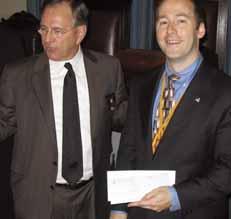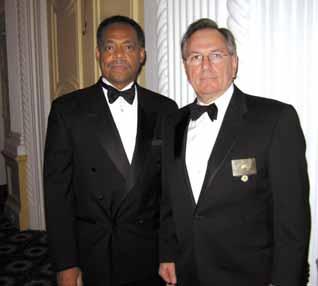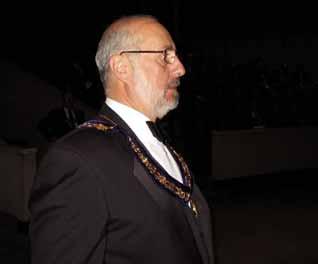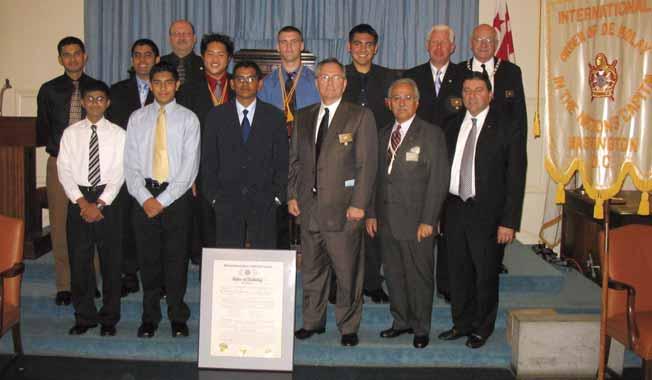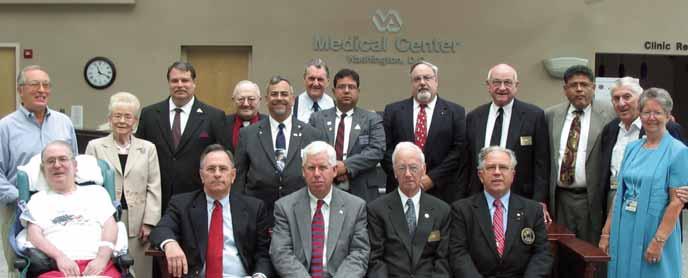
9 minute read
One Good Mason Saved — Another Good Mason Dead
One Good Mason Saved —Another Good
Mason Dead
Advertisement
It is Wednesday, November 1, 1950, one hundred fifty years to the day since John Adams became the first president to occupy The White House. Harry S. Truman is the 33rd president of the United States and extensive repairs to The White House have forced the Truman family to move across Pennsylvania Avenue to the Blair House, usually reserved for use as a temporary residence for visiting dignitaries. It will be the home for the president and his family for almost all of his presidency, and will become quickly dubbed, “The Truman White House.”
Harry Truman’s schedule for the first of November is a bit lighter than usual and by one o’clock, his appointments concluded, he makes the short trip across the street to Blair House to have lunch with Bess and then catch a nap. Later that afternoon, he is scheduled to travel across the Potomac to nearby Arlington National Cemetery to join the British Ambassador and others in unveiling a statue of Sir John Dill, a British Field Marshall who has died while in Washington on assignment as the senior British representative to the Combined Chiefs of Staff.
After lunch, Truman retires to a second floor bedroom at the front of Blair House for a nap. The hour is two o’clock. It won’t be a long nap, for he is scheduled to depart for Arlington National Cemetery at 2:50 p.m. But the next thirty minutes will make that Wednesday a day which Harry Truman will remember for the rest of his life.
He would remember it because of an attempted assassination that day on his life by two Puerto Rican nationalists, Griselio Torresola and Oscar Collazo. Griselio, a full time and totally dedicated Puerto Rican Nationalist, had spent time previously in New York, raising money for the cause and to recruit others to the movement. Oscar, also in New York, was such a man.
Back in Puerto Rico, on October 30, 1950, an attempt at a coup in San Juan collapsed in a bloody barrage of shots in which the sister of Griselio was shot and captured. Now the cause became personal as well as political. It was time to act; to do something to bring attention to the perceived Dean S. Clatterbuck, P.M.
plight of Puerto Ricans living under the thumbs of the yanquis. The time was now, and the deed should be something big. Something like assassinating the President of the United States.
On October 31, 1950, Oscar and Griselio met at Penn Station in New York City and caught a train to Washington, D.C. They walked from Union Station and within a short distance found themselves at the Hotel Harris on Massachusetts Avenue. N.W., where they registered under assumed names and turned in about ten in the evening. The next morning, they walked from the hotel to the U. S. Capitol and calmly took a tour.
Returning to their hotel, they ate lunch, and Griselio gave Oscar some hurried instructions on the use of the weapon Griselio had purchased for him, a Walther P38. Hailing a cab, the men asked to be taken to The White House to see where the president lived. But the cab driver corrected them, telling them that Truman wasn’t living in The White House because it was undergoing renovations — he was living across the street at the Blair House.
Upon their arrival in the area of the Blair House, Griselio and Oscar surveyed the situation and re-formulated an improvised plan, not having known about Blair House until minutes before. As they looked over the scene, they could see two White House Police officers in their guard houses, one at either end of the Blair House.
One of them was forty-year-old Leslie Coffelt, a native Virginian hailing from a small town outside of Strasburg, who had begun his law enforcement career with the Metropolitan Police Department. He briefly left the force to try his hand at other endeavors, but he was a policeman at heart, and he returned to the force. After eight years, he transferred to the White House Police, the Uniformed Division of the Secret Service (and the forerunner of the Executive Protective Service), where he now had seven years of service as a Private, except for a break to serve in the army during World War II.
In an ironic twist of fate, he was scheduled to be off on that day but a fellow officer, one of his best friends, needed some time off to paint his house, so Les offered to work in his place. Les was an active Mason, and a member of Potomac Lodge No. 5, having been raised on September 28, 1945. Les was faithful in his attendance insofar as his rotating shift work at Blair House allowed. Les was hopeful that he might be able to serve as an officer in the Lodge in 1951. It would be an unrealized hope.
The two guard houses on either side of the Blair House (actually, it is two houses, the Blair and Lee houses that have been joined together) were both situated literally on the sidewalk, one at the west end of the Lee House, the other at the east end of the Blair House. At 2:00 p.m., Leslie Coffelt was in the west end guard house. In less than a thirty minutes, he would be mortally wounded. Officer Joe Davidson was on duty in the east end booth. White House Police Officer Donald Birdzell was guarding the front door to Blair House.
At about 2:20 p.m., Griselio and Oscar approached Blair House from opposite directions. Secret Service Agent Floyd Boring had just stepped outside of Blair House for a routine check with his detail. He spoke with Les, then moved to the other corner of the house where he reported to headquarters using the phone in the east booth and he was chatting with Joe Davidson when Oscar Collazo walked by.
Officer Birdzell was facing the Blair House when he suddenly heard a sharp “click.” Intuitively, he recognized the sound as one associated with a firearm and pivoted on the spot. Collazo’s gun had mis-fired as he attempted to shoot Birdzell from point-black range. Now, in extreme frustration, Collazo was pounding the Walther P38 with his left fist, which caused the weapon to fire.
The bullet struck Birdzell in the right knee. In agonizing pain, Birdzell limped out onto Pennsylvania Avenue, turning to return fire at Collazo who had started up the now unguarded steps. Officer Davidson began firing at Collazo from the east guard booth area and Agent Boring also began firing. Collazo sat on the second step and fired a clip of bullets at the two men, but failed to hit either of them.
Agent Stewart Stout, hearing the unmistakable sound of gunfire, had grabbed a submachine gun and taken up a position inside the house at the door. Agent Vince Mroz emerged from the basement door behind Boring and
One Good Mason Saved. Letter expressing the gratitude of President Harry S. Truman.
Davidson and took one shot at Collazo. He then raced back into the Lee House basement to guard against any threat at the basement door at the other end of the building.
Simultaneously, Griselio Torresola had been approaching from the west and arrived at the western guardhouse just as the first gunfire erupted. He was directly behind White House Police Officer, Joe Downs, who was returning to Blair House after making a run to get lunch for the shift. Accustomed to being frequently approached by tourists seeking information, Coffelt was taken completely by surprise. Griselio fired three rounds, hitting Coffelt in the chest, abdomen, and legs. Les sank into his chair, mortally wounded, but still managed to remain conscious and draw his gun. Downs, standing in the doorway, attempted to draw his pistol, but Griselio, an excellent marksman, shot him three times.
Then, seeing Birdzell trying to shoot Collazo from the street, Griselio fired at Birdzell, hitting him in his left knee and disabling him. It appeared that only Agent Mroz and Secret Service Agent Stout remained to guard the presi
umental effort before passing out, aimed his weapon and later identified the bullet as having been fired from under three minutes. It seems virtually certain that the elapsed time was less than a minute.
The sound of gunfire roused Harry Truman from his nap. Arising from his bed, he walked to the front window to see what was going on. He looked out before Les Coffelt fired his fatal shot, but Griselio had emptied his German 9 mm Luger and was in the process of reloading. The assassin’s target was suddenly in plain view.
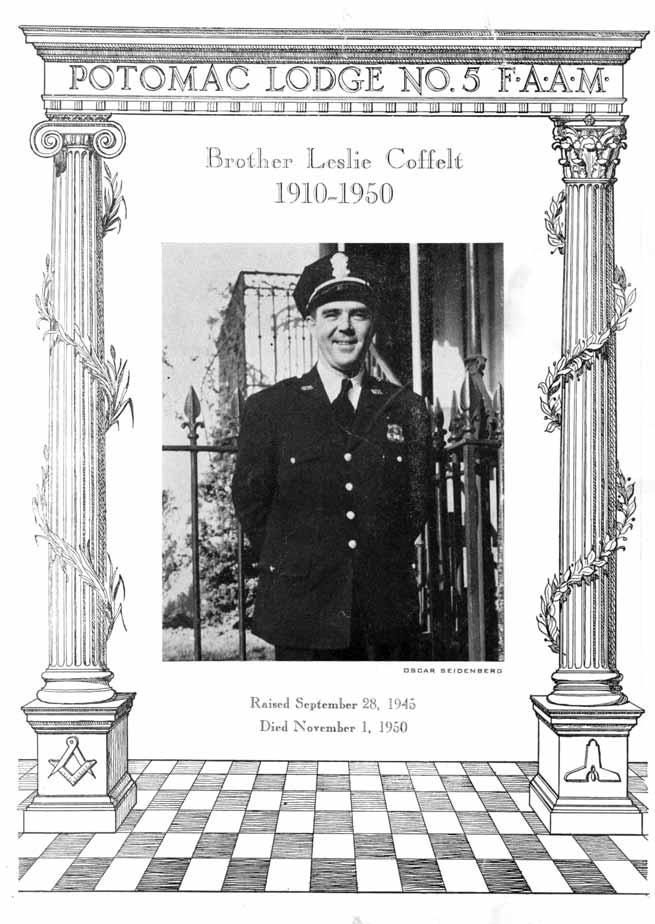
Secret Service Agent Floyd Boring saw Truman at the window and called for him to get out of view. Whether or not Griselio ever saw Truman is unknown, but in any event, Les Coffelt’s final act made the question moot. U. E. Baughman, Chief of the Secret Service was now on the scene, and being uncertain if this was an isolated action or part of a larger plot, advised Truman to cancel his 3:00 trip to Arlington National Cemetery. Truman declined this advice and elected to go ahead, under a quadrupled Secret Service guard.
Agent Birdzell’s wounds were not life-threatening; Downs was seriously Another Good Mason Died. Cover page of the announcement issued at the time of the funeral wounded, but survived. Officer for Brother Leslie Coffelt, White House Police Officer who was slain in defense of the Leslie Coffelt died in the hospital President Harry Truman. less than four hours after being shot. dent, but Coffelt, mustering what must have been a monUniformed Secret Service to lose his life in the line of duty. fired. His aim was true. His shot struck Griselio in the Collazo also recovered from his wounds and was subsehead, killing him instantly. quently tried and sentenced to death. President Truman, At the same time, Boring had zeroed in on his target and sentence to life imprisonment. President Jimmy Carter took a shot at Collazo. Collazo was hit in the chest, later ordered a now aged Collazo released and he returned wounding him and also putting him out of action. (Tests to Puerto Rico where he died of natural causes in 1994. He was the first member of the not wanting to see Collazo become a martyr, commuted his Officer Davidson’s gun.) It was over! All of the action had Three days after the assassination attempt, Harry Truman happened in a flash. Later estimates would range from as again returned to Arlington National Cemetery. This time, short a span of time as less than forty seconds to as long as it was not to make a speech or help dedicate a statue. It was continued on page 28

